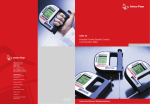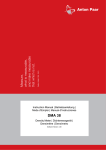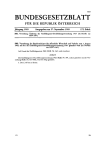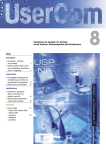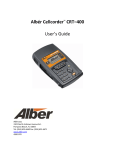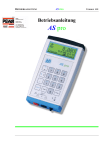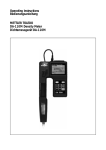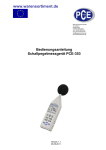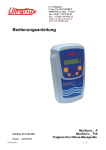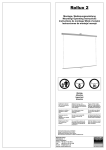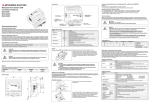Download DMA 35N - Masterflex
Transcript
DMA 35N Portable Density/Specific Gravity/ Concentration Meter ::: Unique Density & Concentration Meters Instruction Manual | Betriebsanleitung DMA 35N Portable Density Meter Software Version: V2.014 Instruction Manual Anton Paar GmbH Anton-Paar-Strasse 20 A-8054 Graz / AUSTRIA – EUROPE Tél: +43 316 257-0 Fax: +43 316 257-257 Email: [email protected] Web: http://www.anton-paar.com While every precaution has been taken in the preparation of this document, Anton Paar GmbH assumes no responsibility for technical or printing errors or omissions. Nor is any liability assumed for damages resulting from the use of the information contained in this instruction manual. Anton Paar GmbH does not make a commitment to update the information in this manual. Specifications are subject to change without notice. All rights reserved (including translation). No part of this document may be translated, reproduced or distributed in any form (print, photocopy, microfilm or any other process) without the prior written permission of Anton Paar GmbH. Trade marks may be used in this instruction manual without being marked as such. These are the property of their respective owners and are legally protected. Published by Anton Paar GmbH. Printed in Austria. Copyright © 2003 Anton Paar GmbH, Graz, Austria Date: 26.09.2003 Document number: B46IB01H.fm Contents 1 Introduction .......................................................................................................... 7 2 Safety Instructions .............................................................................................. 8 2.1 Safety Measures for Use in Hazardous Areas .............................................. 9 2.1.1 Starting Up and Starting Up after Service ....................................... 9 2.1.2 Battery Exchange ........................................................................... 9 2.1.3 Infrared/RS 232 Interface Port ........................................................ 9 3 Symbols in the Manual ...................................................................................... 10 4 Supplied Items ................................................................................................... 11 5 Functional Description ...................................................................................... 12 5.1 Front View ................................................................................................... 12 5.2 Rear View ................................................................................................... 13 5.3 Keys ............................................................................................................ 14 5.4 The Display ................................................................................................. 15 6 Operating the DMA 35N ..................................................................................... 16 6.1 Connecting the Filling Tube ........................................................................ 16 6.2 Turning On the Instrument .......................................................................... 17 6.3 Turning Off the Instrument .......................................................................... 17 7 Units and Custom Functions ............................................................................ 18 7.1 Activating a Unit or Custom Function .......................................................... 18 7.2 Description of Units and Custom Functions ................................................ 19 8 Measurement ...................................................................................................... 22 8.1 Filling with the Built-in Pump ....................................................................... 23 8.2 Filling with the Plastic Syringe ..................................................................... 24 8.3 Storage of Measuring Results ..................................................................... 25 8.3.1 Manual Storage ............................................................................ 25 8.3.2 Automatic Storage ........................................................................ 25 8.4 Recalling Stored Results ............................................................................. 25 B46IB01 5 8.5 Printing Stored Results ................................................................................26 8.6 Deleting Stored Results ...............................................................................26 9 Maintenance .......................................................................................................27 9.1 Cleaning the Measuring Cell and the Built-in Pump ....................................27 9.2 Battery Exchange ........................................................................................28 10 Readjustment ...................................................................................................29 11 Data Transfer to Printer/PC .............................................................................31 12 Error Messages ................................................................................................33 13 Technical Data ..................................................................................................34 Appendix A: Density of Water (0 °C to 40 °C) .....................................................35 Appendix B: CE-Declaration of Conformity ........................................................36 Appendix C: EC Type Examination Certificate ...................................................37 6 B46IB01 1 • • • • • Introduction The DMA 35N portable density meter measures the density of liquids in g/cm3 or kg/m3 according to the U-tube principle. Samples are filled into the measuring cell using the built-in pipette-style pump or a syringe. A temperature sensor measures the sample temperature right at the measuring cell. The temperature is displayed and can be used internally for automatic temperature compensation of the density reading. Once activated, automatic conversion of density into relative density, density at reference temperature or concentration (H2SO4, API number, °Brix, °Baumé, °Plato, % alcohol, etc.) is performed immediately. 1024 measuring results including temperature can be stored in the memory of the DMA 35N. Results can be recalled individually, or transferred to a printer or PC using an infrared/RS 232 interface port (option). B46IB01 7 2 • • • • • • • • • • • Safety Instructions This instruction manual does not purport to address all of the safety problems associated with the use of the instrument and samples. It is the responsibility of the user of the instrument to establish safety and health practices and determine the applicability of regulatory limitations prior to use. Before using the DMA 35N read the instruction manual. Anton Paar GmbH warrants the proper functioning of the DMA 35N, if no unauthorized adjustments have been made in mechanical parts, electronic parts and software, and the following points are adhered to. Follow all hints, warnings and instructions in the instruction manual to ensure correct and safe functioning of the DMA 35N. Do not use the DMA 35N for any purpose other than described in the instruction manual. Do not use any accessories other than those supplied or approved by Anton Paar GmbH. Do not operate the DMA 35N if a malfunction is suspected, or damages or injuries or loss of life of persons cannot be excluded under all circumstances. The digital density meter DMA 35N is suitable for use in hazardous areas only if the instrument is labelled with the ATEX registration number. Due to the nature of the measurement the measuring results not only depend upon the correct use and functioning of the DMA 35N, but may also be influenced by other factors. Therefore it is advised, that the analysis results are plausibility tested before consequential actions are taken. Follow the precautions below for the handling and measurement of inflammable samples and cleaning materials: - Store no inflammable material near the instrument. - Do not leave sample containers uncovered. - Clean all spillages immediately. - Ensure that the instrument is located in a sufficiently ventilated area, free from inflammable gases and vapours. Do not expose the instrument to temperatures below 0 °C (32 °F) if water is contained in the measuring cell or pump. Freezing water will cause rupture of the measuring cell. Important: Do not drop the DMA35N! Vigorous vibrations and mechanical shocks will destroy the glass measuring cell. 8 B46IB01 2.1 Safety Measures for Use in Hazardous Areas 2.1.1 Starting Up and Starting Up after Service • The DMA 35N is suitable for use in hazardous areas only if the instrument is labelled with the ATEX registration number (see appendix C). • The intrinsically safe DMA 35N can be used according to ATEX marking II 2 G EEx ib IIC T5. All instructions given in the certificate of conformity have to be followed (see appendix C). By labelling the intrinsically safe DMA 35N with the type plate according to ATEX, Anton Paar GmbH confirms that the instrument conforms with all documents submitted for receiving the certificate of conformity. Therefore, do not subject the intrinsically safe DMA 35N to alterations of any kind. Repaired instruments may be operated only if the repair was carried out by Anton Paar GmbH. The type plate according to ATEX still confirms that the intrinsically safe DMA 35N conforms with all documents submitted for receiving the certificate of conformity. • • 2.1.2 Battery Exchange • • • • Use only batteries of the same type and in the same level of charge. When exchanging the batteries, always check that the small parting plate is inside the battery compartment chamber and properly fixed. After the battery exchange (outside the hazardous area), close the battery cover and fix it with the Phillips screw. Check the function of the instrument: Turn the instrument on and check the display. 2.1.3 Infrared/RS 232 Interface Port • Never use the infrared/RS 232 interface port in hazardous areas. B46IB01 9 3 Symbols in the Manual The following symbols are used in this instruction manual: The "Warning" sign points out a hazard. It calls attention to a procedure, or the like, which, if not correctly performed or adhered to, could result in injury or loss of life. Do not proceed beyond a "Warning" sign until indicated conditions are fully understood and met. The "Important" sign points out a hazard. It calls attention to an operating procedure, practice, or the like, which, if not correctly performed or adhered to, could result in damage or destruction of the equipment or parts of it. Do not proceed beyond a "Important" sign until the indicated conditions are fully understood and met. The "Hint" sign points out a remark. It calls attention to any additional information which might be of use for the operator. 10 B46IB01 4 1 2 3 4 5 6 7 8 Supplied Items Filling tube (standard) or long filling tube (option) Adapter Luer 1/4" UNF (syringe filling) Infrared/RS 232 interface port (option) Plastic syringes Instruction manual Instrument box DMA 35N Adapter printer 25/9-pin (option) B46IB01 11 5 Functional Description 5.1 Front View 1 2 3 4 5 6 7 8 12 Display Measuring cell Filling tube Screw plug Built-in pump Pump lock Operating keys Infrared interface connection B46IB01 5.2 1 2 3 4 5 6 7 Rear View Data storage key Screw for battery cover Battery cover Warning plate Type plate DKD calibration number (option) Registration number and ATEX marking (only for DMA 35N Ex versions) B46IB01 13 5.3 • • • • Keys All keys have multiple functionality. A short push of a key activates its primary function. A long push of a key activates its secondary function. Further functions can be activated by pushing 2 keys simultaneously. Front 1 2 3 4 14 Rear "ON/OFF" key to switch the instrument on and off. "Recall/Delete" key to recall or delete results stored in the memory. "Print/Print all" key to transfer data to a printer or PC. "store" key to store results in the memory. B46IB01 5.4 1 2 3 4 5 6 7 8 9 10 The Display Measuring value Units and custom functions Temperature display °C/°F Low battery indicator Readjustment mode Set mode Consecutive number of values in memory Temperature coefficient Display frozen during storage procedure Automatic data storage B46IB01 15 6 Operating the DMA 35N 6.1 Connecting the Filling Tube • • 16 Screw in the filling tube clockwise by hand until some resistance against turning can be felt. Do not use any tools to prevent damage of the thread. B46IB01 6.2 • • • 6.3 • • Turning On the Instrument Push the "ON/OFF" key for at least 2 seconds. The instrument performs a short self-test procedure, all required segments of the display will light up. Subsequently, the °C (or °F) will start flashing, indicating that the instrument is in the measuring mode. Turning Off the Instrument Push the "ON/OFF" key until "OFF" appears on the display, then release the key. The DMA 35N is automatically switched off if no key is pushed for 15 minutes. B46IB01 17 7 Units and Custom Functions 7.1 Activating a Unit or Custom Function • Pushing the "ON/OFF" and "store" keys simultaneously activates the "SET" mode. Display: Hint: All stored results are deleted from the memory if the "SET" mode is activated. • • • • 18 A long push of the "store" key activates the selection of the temperature unit (°C/ °F). - Toggle between °F and °C with a short push of the "store" key. - Store your selection and move further to activate density or a density-related custom function by a long push of the "store" key. Move through the list of choices by pushing the "store" key shortly. To activate the displayed function give the "store" key a long push. The instrument is automatically switched off, and after turning it on again the selected density or density-related function will be displayed. B46IB01 7.2 Description of Units and Custom Functions API A B D Display of the API number for product group A, B or D, referred to reference temperature 15 °C or 60 °F. Product group A: Crude oil Product group B: Fuel Product group D: Lubricants API A B D SG 15/15 ou 60/60 Display of the Specific Gravity for product group A, B or D, referred to reference temperature 15 °C or 60 °F. Product group A: Crude oil Product group B: Fuel Product group D: Lubricants API A B D g/cm3 Display of the Density in g/cm3 for product group A, B or D, referred to reference temperature 15 °C or 60 °F. Product group A: Crude oil Product group B: Fuel Product group D: Lubricants API A B D kg/m3 Display of the Density in kg/m3 for product group A, B or D, referred to reference temperature 15 °C or 60 °F. Product group A: Crude oil Product group B: Fuel Product group D: Lubricants SG (Specific gravity) • Specific gravity or relative density is the density of the sample (at selected reference temperature) divided by density of water (at selected reference temperature). B46IB01 19 • • The influence of sample temperature is compensated using the temperature coefficient (g.cm-3.K-1). Examples for temperature coefficients of common samples at 20 °C: - Most aqueous solutions 0 to 20 %: 3x10-4 - Most aqueous solutions 10 to 50 %: 5x10-4 - Many organic liquids: 10x10-4 - The temperature coefficient can be calculated according to the formula: ρ1 – ρ2 Temperature coefficient = ----------------t1 – t2 ρ1 ... density at temperature t1 ρ2 ... density at temperature t2 The reference temperatures (for example 20/04) and the temperature coefficient (g.cm-3.K-1) have to be entered. - The reference temperatures are entered in the unit selected (°C or °F), the temperature coefficient always has to be entered in the unit g.cm-3.K-1. - If SG t1/t2 is displayed in the "SET" mode, give the "store" key a long push. Now each of the four digits of the temperatures can be subsequently set using short pushes of the "store" key. Store each setting with a long push, this brings you to the next digit. - After setting the 2 reference temperatures, the temperature coefficient can be set (from 0 to 19x10-4). A short push of the "store" key increases the digit, a long push stores the selected number. Then the instrument switches off automatically. g/cm3 or kg/m3 Measurement of true density in g/cm3 or kg/m3 at displayed measuring temperature. %H2SO4 Display of concentration of sulfuric acid (battery acid) in % by weight at 20 °C derived from density at measuring temperature. °BRIX Display of Brix degrees (sucrose concentration in % by weight) at 20 °C derived from density at measuring temperature. 20 B46IB01 °BAUMÉ • Display of Baumé degrees. After storing the setting with a long push of the "store" key, the temperature coefficient can be set. • Set the correct temperature coefficient (from 0 to 19x10-4) according to the following procedure: - A short push of the "store" key increases the digit. - A long push stores the selected number. - Then the instrument switches off automatically. °PLATO Display of Plato degrees at 20 °C derived from density at measuring temperature. %ALC/W, %ALC/V • Display of alcohol concentration of ethanol/water mixtures in % by weight or by volume at 20 °C derived from density at measuring temperature. • Switch from % by volume (V) to % by weight (W) using a short push of the "store" key. PROOF Display of Proof degrees at 60 °F derived from density at measuring temperature. CUSTOM A custom-tailored polynomial function can be stored. Please contact your local Anton Paar distributor. PEr Displays the period value of the measuring cell. rES Displays a value for the factory adjustment. B46IB01 21 8 Measurement Important: • Before any measurements are performed, check the resistance of all materials in contact with the sample. • Materials in contact with the sample are: - PTFE (pump piston, filling tube) - Borosilicate glass (measuring cell, pump cylinder) • Before performing any measurements, prepare suitable cleaning agents or solvents. Hints: • The sample has to be filled into the measuring cell free of any bubbles. Bubbles seriously interfere with the measurement. Possible sources of bubbles are: - Leakage at the connection of the filling tube or the screw plug. - Gas bubbles contained in the sample. • The measuring cell has to be completely filled. • The sample temperature should not be lower than the ambient temperature. • Carefully clean the measuring cell after each series of measurements to avoid deposit of coatings. • The displayed temperature value is flashing as long as the temperature of the filled sample exceeds the temperature specification of the DMA 35N (0 to 40 °C). Measuring results will be displayed, but it is recommended to wait until the temperature display stops flashing. • The flashing temperature unit (°C or °F) indicates the proper functioning of the instrument. 22 B46IB01 8.1 1. 2. 3. Filling with the Built-in Pump Push down the lever of the pump. Submerge the filling tube in the sample. Slowly release the pump lever. B46IB01 23 8.2 1. 2. 3. Filling with the Plastic Syringe Remove the screw plug using a coin. Screw in the adapter Luer 1/4" UNF (see chapter 4). Fill the sample into the measuring cell using the syringe. Hint: Do not remove the pump when filling with a syringe, the pump is necessary to seal the filling system. 24 B46IB01 8.3 Storage of Measuring Results Hints: • No storage is possible if the "low battery" sign appears on the display. • Activating the "SET" mode deletes all stored results. 8.3.1 Manual Storage • • • • A long push of the "store" key immediately stores the current measuring result in the memory together with a sample number. "HOLD" is displayed. The sample number starts at 1 and is automatically increased by one with each new stored measuring value. 1024 results can be stored. 8.3.2 Automatic Storage • • • • 8.4 • • • A short push of the "store" key activates the automatic storage procedure. "AUTO" is displayed. The instrument automatically checks the temperature stability of the sample. If temperature is stable within 0.2 degrees for 10 subsequent measurements, then the value is automatically stored together with a sample number. A minimum of 15 seconds is required per automatic storage procedure. Recalling Stored Results A short push of the "Recall/Delete" key shows the latest stored value on the display for 10 seconds. If the "Recall/Delete" key is pushed again shortly within this time, subsequently all stored results can be displayed from the latest to the oldest value. If the key is not pushed within 10 seconds the display is switched back to the current measuring value. B46IB01 25 8.5 • • • • Printing Stored Results A short push of the "Print/Print all" key initiates the data transfer of the current measuring value to printer or PC. A long push of the "Print/Print all" key initiates the data transfer of all stored measuring values to printer or PC. The printed value is shown on the display. Stop the printout by switching the instrument off. Example for a printout: # 1 2 3 4 8.6 • • 26 T [C] g/cm3 23.6 0.9973 23.9 0.9972 25.5 0.9961 ...... ......... Deleting Stored Results To delete the latest stored value, push and hold the "Delete" key. "Memory" will flash 4 times before the value is deleted. To delete all results push and hold the "Delete" and "Print/Print all" keys simultaneously until the countdown on the display starting from 9 has reached 0, and a peep sounds. Releasing the keys before 0 is reached does not delete the values. B46IB01 9 Maintenance 9.1 Cleaning the Measuring Cell and the Built-in Pump Important: Only use solvents or cleaning agents that do not attack any of the wetted parts of the DMA 35N. • • Fill the cleaning agent using the built-in pump or a plastic syringe. Repeatedly flush cleaning agent through the complete measuring system. B46IB01 27 9.2 Battery Exchange • When the "low battery" signal is displayed, no more data can be stored. • The batteries must be exchanged. Warning: • Do not open the battery cover in hazardous areas. • Only exchange the batteries outside the hazardous area. Warning: • When inserting new batteries check that the polarity is correct. • Use only batteries of the same type and same level of charge. Please note, when using the DMA 35N Ex or DMA 35N Ex Petrol: Warning: • When exchanging the batteries, always check that the small parting plate is in the battery chamber and is properly fixed. • After the battery exchange, close the battery cover and fix it with the Phillips screw. • Check the function of the instrument: Turn the instrument on and check the display. 28 B46IB01 10 • • • • Readjustment Proper cleaning of the measuring cell is required before and after each series of measurements. Poor cleaning can result in the formation of deposits in the measuring cell. This can cause offsets of the density readings, and can be recognized by measuring distilled water. If the density value deviates more than ±0.001 g/cm3 from the theoretical value (see appendix), then a readjustment may be necessary. A readjustment is only possible if the density difference between measured and theoretical value is below 0.100 g/cm3, and the water temperature is between 15 and 25 °C. How to readjust: 1. Clean the measuring cell with a suitable cleaning agent until no more residues or deposits are visible. 2. Remove the cleaning agent completely from the measuring cell. 3. Fill distilled water of approx. 20 °C into the measuring cell, carefully avoiding the introduction of bubbles. The ambient temperature should be between 15 °C and 25 °C. 4. Turn the instrument off. Turn the instrument on again, pushing both the "ON/ OFF" key and the "Recall/Delete" key at the same time. 5. The measured density and "ADJ" are displayed. The water temperature has to be between 15 and 25 °C, the density must be between 0.900 and 1.100 g/cm3. B46IB01 29 6. The instrument checks automatically the stability of the reading during 10 subsequent measuring sequences. Upon stability, the density deviation between the measured and theoretical water density are displayed: 7. • • 30 Store the readjustment with a long push of the "store" key. If storing the readjustment is not desirable, then turn off the instrument. B46IB01 11 Data Transfer to Printer/PC • For data transfer from the DMA 35N to a printer or PC the infrared/RS 232 interface port (option) is required. • Interface plug: Pin 2: TXD Pin 3: RXD Pin 4: DTR Pin 5: GND Pin 7: RTS • Interface plug Printer/PC • Printer requirements for the data transfer: - Serial interface - Lines TXD and DTR must have a minimum voltage of -9 V. • Connection of the printer/PC: Warning: Never use the interface port in hazardous areas. Connect the DMA 35N to the printer/PC using the infrared/RS 232 interface port. - Slide the black connector from the rear of the DMA 35N into the 2 grooves on the side of the instrument until the catch spring locks. - The lever of the spring has to be on the rear. B46IB01 31 If the printer does not provide this voltage, then connect a standard 9 to 12 VDC power supply to the supply inlet (2) of the printer adapter plug (1). Printer • Specifications of the interface: 7 data bits 1 parity bit, even parity 1 stop bit 9600 baud rate • 1. 2. 3. 32 How to transfer data to a PC: Select the correct data transfer setting on the PC. - A short push of the "Print/Print all" key initiates the data transfer of the current measuring value. - A long push of the "Print/Print all" key initiates the data transfer of all data from the memory of the DMA 35N to the PC. Disconnect the connector by pushing the catch spring on the rear and simultaneously sliding back the connector. Received and processed by standard terminal software (like Windows® Terminal, Procomm, Hyper Terminal, etc.). B46IB01 12 Error Messages Error message Cause OSC No oscillation. -,---- Measuring range exceeded. B46IB01 33 13 Technical Data Measuring range: Density: 0 to 1.999 g/cm3 Temperature: 0 to 40 °C, 32 to 104 °F Viscosity: 0 to approx. 1000 mPa.s Uncertainty of measurement: Density: ±0.001 g/cm3 Temperature: ±0.2 °C Repeatability: Density: ±0.0005 g/cm3 Temperature: ±0.1 °C Resolution: Density: 0.0001 g/cm3 Temperature: 0.1 °C or 0.1 °F Sample volume: approx. 2 ml Sample temperature: 0 to 100 °C Ambient temperature: 0 to +40 °C Air humidity: 5 to 90 % relative humidity, non-condensing Protection class: IP 54 (Use in light rainfall/snowfall possible) Memory: 1024 values Interface: Infrared/RS 232 Power supply: 2x1.5 V Alkaline batteries Micro LR03 (Use only batteries of the same type and same level of charge) Housing: Polypropylene or Stat-Kon NS (resistant against petrochemical products) Dimensions: 140x130x25 mm Weight: 275 g (9.7 oz) 34 B46IB01 Appendix A: Density of Water (0 °C to 40 °C) t°C 0.0 0.1 0.2 0.3 0.4 0.5 0.6 0.7 0.8 0.9 0 .99984 .99985 .99985 .99986 .99987 .99987 .99988 .99988 .99989 .99989 1 .99990 .99990 .99991 .99991 .99992 .99992 .99993 .99993 .99993 .99994 2 .99994 .99994 .99995 .99995 .99995 .99995 .99996 .99996 .99996 .99996 3 .99996 .99997 .99997 .99997 .99997 .99997 .99997 .99997 .99997 .99997 4 .99997 .99997 .99997 .99997 .99997 .99997 .99997 .99997 .99997 .99997 5 .99996 .99996 .99996 .99996 .99996 .99995 .99995 .99995 .99995 .99994 6 .99994 .99994 .99993 .99993 .99993 .99992 .99992 .99991 .99991 .99991 7 .99990 .99990 .99989 .99989 .99988 .99988 .99987 .99987 .99986 .99985 8 .99985 .99984 .99984 .99983 .99982 .99982 .99981 .99980 .99980 .99979 9 .99978 .99977 .99977 .99976 .99975 .99974 .99973 .99973 .99972 .99971 10 .99970 .99969 .99968 .99967 .99966 .99965 .99964 .99963 .99962 .99961 11 .99960 .99959 .99958 .99957 .99956 .99955 .99954 .99953 .99952 .99951 12 .99950 .99949 .99947 .99946 .99945 .99944 .99943 .99941 .99940 .99939 13 .99938 .99936 .99935 .99934 .99933 .99931 .99930 .99929 .99927 .99926 14 .99924 .99923 .99922 .99920 .99919 .99917 .99916 .99914 .99913 .99911 15 .99910 .99908 .99907 .99905 .99904 .99902 .99901 .99899 .99897 .99896 16 .99894 .99893 .99891 .99889 .99888 .99886 .99884 .99883 .99881 .99879 17 .99877 .99876 .99874 .99872 .99870 .99869 .99867 .99865 .99863 .99861 18 .99859 .99858 .99856 .99854 .99852 .99850 .99848 .99846 .99844 .99842 19 .99840 .99838 .99836 .99835 .99833 .99831 .99828 .99826 .99824 .99822 20 .99820 .99818 .99816 .99814 .99812 .99810 .99808 .99806 .99803 .99801 21 .99799 .99797 .99795 .99793 .99790 .99788 .99786 .99784 .99781 .99779 22 .99777 .99775 .99772 .99770 .99768 .99765 .99763 .99761 .99758 .99756 23 .99754 .99751 .99749 .99747 .99744 .99742 .99739 .99737 .99734 .99732 24 .99730 .99727 .99725 .99722 .99720 .99717 .99715 .99712 .99709 .99707 25 .99704 .99702 .99699 .99697 .99694 .99691 .99689 .99686 .99683 .99681 26 .99678 .99676 .99673 .99670 .99667 .99665 .99662 .99659 .99657 .99654 27 .99651 .99648 .99646 .99643 .99640 .99637 .99634 .99632 .99629 .99626 28 .99623 .99620 .99617 .99615 .99612 .99609 .99606 .99603 .99600 .99597 29 .99594 .99591 .99588 .99585 .99582 .99579 .99577 .99574 .99571 .99568 30 .99564 .99561 .99558 .99555 .99552 .99549 .99546 .99543 .99540 .99537 31 .99534 .99531 .99528 .99524 .99521 .99518 .99515 .99512 .99509 .99506 32 .99502 .99499 .99496 .99493 .99490 .99486 .99483 .99480 .99477 .99473 33 .99470 .99467 .99463 .99460 .99457 .99454 .99450 .99447 .99444 .99440 34 .99437 .99433 .99430 .99427 .99423 .99420 .99417 .99413 .99410 .99406 35 .99403 .99399 .99396 .99393 .99389 .99386 .99382 .99379 .99375 .99372 36 .99368 .99365 .99361 .99358 .99354 .99350 .99347 .99343 .99340 .99336 37 .99333 .99329 .99325 .99322 .99318 .99314 .99311 .99307 .99304 .99300 38 .99296 .99292 .99289 .99285 .99281 .99278 .99274 .99270 .99267 .99263 39 .99259 .99255 .99252 .99248 .99244 .99240 .99236 .99233 .99229 .99225 40 .99221 .99217 .99214 .99210 .99206 .99202 .99198 .99194 .99190 .99186 B46IB01 35 Appendix B: CE-Declaration of Conformity 36 B46IB01 Appendix C: EC Type Examination Certificate B46IB01 37 38 B46IB01 B46IB01 39 40 B46IB01 DMA 35N Tragbares Dichte-Messgerät Softwareversion: V2.014 Betriebsanleitung Anton Paar GmbH Anton-Paar-Strasse 20 A-8054 Graz / AUSTRIA – EUROPE Tél: +43 316 257-0 Fax: +43 316 257-257 Email: [email protected] Web: http://www.anton-paar.com Dieses Dokument wurde mit der nötigen Sorgfalt erarbeitet; die Anton Paar GmbH übernimmt keinerlei Haftung für verbleibende technische und drucktechnische Fehler oder Auslassungen in diesem Dokument. Außerdem wird keinerlei Haftung übernommen für Schäden, die sich durch die im Dokument enthaltene Information ergeben. Anton Paar GmbH behält sich inhaltliche Änderungen vor. Dies gilt auch für Änderungen des Lieferumfangs in Form, Ausstattung und Technik. Alle Rechte (inkl. Übersetzung) vorbehalten. Dieses Dokument darf in keiner Form (Druck, Fotokopie, Mikrofilm oder einem anderen Verfahren), auch nicht auszugsweise, ohne schriftliche Genehmigung der Firma Anton Paar GmbH reproduziert oder unter Verwendung elektronischer Systeme verarbeitet, vervielfältigt oder verbreitet werden. Warenzeichen, eingetragene Warenzeichen, Handelsbezeichnungen und ähnliches werden in dieser Betriebsanleitung verwendet, ohne als solche gekennzeichnet zu sein. Sie sind Eigentum ihrer jeweiligen Inhaber. Herausgegeben von Anton Paar GmbH. Gedruckt in Österreich. Copyright © 2003 Anton Paar GmbH, Graz, Österreich Datum: 26.09.2003 Dokumentnummer: B46IB01H.fm Inhaltsverzeichnis 1 Einleitung ........................................................................................................... 45 2 Sicherheitshinweise .......................................................................................... 46 2.1 Maßnahmen für die Verwendung im explosionsgefährdeten Bereich ......... 47 2.1.1 Inbetriebnahme und Wiederinbetriebnahme nach Reparatur ....... 47 2.1.2 Batteriewechsel ............................................................................ 47 2.1.3 Infrarotschnittstelle ........................................................................ 48 3 Symbole in dieser Betriebsanleitung ............................................................... 49 4 Lieferumfang ...................................................................................................... 50 5 Beschreibung des Gerätes ............................................................................... 51 5.1 Vorderansicht .............................................................................................. 51 5.2 Rückansicht ................................................................................................ 52 5.3 Tastenfunktionen ........................................................................................ 53 5.4 Anzeige ....................................................................................................... 54 6 Inbetriebnahme .................................................................................................. 55 6.1 Anschluss des Einsaugrohres ..................................................................... 55 6.2 Einschalten des Gerätes ............................................................................. 56 6.3 Ausschalten des Gerätes ............................................................................ 56 7 Einheiten und Kundenfunktionen .................................................................... 57 7.1 Einstellen der Einheiten und Kunden-funktionen ........................................ 57 7.2 Beschreibung der Kundenfunktionen .......................................................... 58 8 Messen ................................................................................................................ 61 8.1 Befüllen mit der Einsaugpumpe .................................................................. 62 8.2 Befüllen mit der Spritze ............................................................................... 63 8.3 Speichern von Messwerten ......................................................................... 64 8.3.1 Manuelle Speicherung .................................................................. 64 8.3.2 Automatische Speicherung ........................................................... 64 8.4 Aufrufen von gespeicherten Messwerten .................................................... 64 B46IB01 43 8.5 Ausdruck von gespeicherten Messwerten ...................................................65 8.6 Löschen von Messwerten ............................................................................65 9 Wartung ...............................................................................................................66 9.1 Reinigung der Messzelle und der Einsaugpumpe .......................................66 9.2 Batterietausch ..............................................................................................66 10 Nachjustierung .................................................................................................68 11 Datenübertragung auf Drucker/PC .................................................................70 12 Fehlermeldungen .............................................................................................72 13 Technische Daten ............................................................................................73 Anhang A: Dichte von Wasser (0 °C bis 40 °C) ..................................................74 Anhang B: CE-Konformitätserklärung ................................................................75 Anhang C: EG Baumuster Prüfbescheinigung ..................................................76 44 B46IB01 1 • • • • • • Einleitung Das DMA 35N ist ein tragbares Messgerät zur Bestimmung der Dichte (g/cm3 bzw. kg/m3) von Flüssigkeiten. Die Glasmesszelle arbeitet nach dem Biegeschwingerprinzip. Das Befüllen der Proben erfolgt mit der eingebauten Einsaugpumpe oder mittels Spritze. Die Temperatur der Probe wird durch einen eingebauten Temperaturfühler direkt an der Messzelle gemessen und an der Anzeige angezeigt. Die gemessene Temperatur wird auch zur Kompensation des Temperatureinflusses auf die Dichte der zu messenden Probe verwendet. Die Dichte wird automatisch in die relative Dichte, in eine temperaturkompensierte Dichte oder durch Einstellung von Kundenfunktionen in eine Konzentration (z.B. H2SO4, API Zahl, °Brix, °Baumé, °Plato, % Alkohol, etc.) umgerechnet. Im Dichtemessgerät DMA 35N können bis zu 1024 Messwerte gespeichert und zu einem späteren Zeitpunkt wieder abgerufen oder ausgedruckt werden. Die Datenübertragung der gespeicherten Messwerte zu einem PC oder Drucker erfolgt über die optionelle Infrarot/RS 232 Schnittstelle. B46IB01 45 2 • • • • • • • • • • 46 Sicherheitshinweise Diese Betriebsanleitung erhebt keinen Anspruch auf vollständige Auflistung aller Sicherheitsaspekte bezüglich Messgerät und Messproben. Es obliegt der Verantwortung des Benutzers, alle Sicherheits- und Arbeitnehmerschutzvorkehrungen einzuhalten. Vor Inbetriebnahme des DMA 35N die Betriebsanleitung lesen. Die Anton Paar GmbH garantiert die ordnungsgemäße Funktion des DMA 35N nur, wenn keine Veränderungen an der Mechanik, Elektronik und Software vorgenommen werden und nachfolgende Punkte eingehalten werden. Alle Hinweise und Bedienungsvorschriften, die in der vorliegenden Betriebsanleitung angeführt sind, müssen beachtet und eingehalten werden, da dies für einen störungsfreien Betrieb und sicheren Zustand des DMA 35N unerlässlich ist. Das DMA 35N darf nur für den in dieser Betriebsanleitung beschriebenen Einsatzzweck verwendet werden. Das DMA 35N darf nur mit dem von der Anton Paar GmbH gelieferten und/oder freigegebenen Zubehör und Verbrauchsmaterial betrieben werden. Im Falle einer Störung darf das DMA 35N nicht weiter verwendet werden. Es darf in keine Betriebszustände gebracht werden, die zur Beschädigung von Sachen oder Gefährdung von Personen führen können. Das DMA 35N darf nur dann in explosionsgefährdeten Bereichen in Betrieb genommmen werden, wenn es mit der ATEX-Zulassungsnummer gekennzeichnet ist. Da es sich beim DMA 35N um ein Messgerät handelt, dessen Messergebnisse nicht nur von der korrekten Funktion, sondern auch von einer Reihe von Randbedingungen abhängen, sind die vom Messgerät gelieferten Resultate einer Begutachtung (z.B. Plausibilitätsprüfung) durch einen Fachmann zu unterziehen, bevor auf die Messwerte bezogene, weiterführende Maßnahmen getroffen werden. Schutzmaßnahmen bei der Messung/Handhabung leicht entzündlicher Proben und Spülflüssigkeiten: - Nur minimal erforderliche Mengen an Proben, Spülflüssigkeiten und anderen brennbaren Materialien im Bereich des DMA 35N lagern. - Proben/Spülflüssigkeiten nicht ausschütten und nicht unverschlossen stehen lassen. - Verschüttete Proben/Spülflüssigkeiten sofort entfernen. - Für eine ausreichende Belüftung des Aufstellungsortes sorgen. Die Umgebung des DMA 35N muss frei von brennbaren Gasen und Dämpfen gehalten werden. B46IB01 • Das DMA 35N darf nicht unter 0 °C abgekühlt werden, solange sich Wasser in der Messzelle oder in der Pumpe befindet (gefrierendes Wasser sprengt die Messzelle). Wichtig: Heftige Erschütterungen und Stöße müssen unbedingt vermieden werden, da diese zur Zerstörung der Glasmesszelle führen. 2.1 Maßnahmen für die Verwendung im explosionsgefährdeten Bereich 2.1.1 Inbetriebnahme und Wiederinbetriebnahme nach Reparatur • • • • Das DMA 35N ist zur Verwendung in explosionsgefährdeten Bereichen nur dann geeignet, wenn es mit der ATEX-Zulassungsnummer gekennzeichnet ist (siehe Anhang C). Das eigensichere DMA 35N darf nach ATEX Kennzeichnung II 2 G EEx ib IIC T5 verwendet werden. Die in der Zulassung angeführten Angaben sind zu beachten (siehe Anhang C). Durch das Anbringen des Typenschilds nach ATEX bestätigt die Anton Paar GmbH die Übereinstimmung des eigensicheren DMA 35N mit jenen Unterlagen, die zur Erteilung der Konformitätsbescheinigung führten. Selbstätige Eingriffe und Veränderungen am eigensicheren DMA 35N sind daher nicht gestattet. Die Wiederinbetriebnahme eines reparierten eigensicheren DMA 35N durch den Betreiber ist ohne weitere Maßnahmen möglich, wenn die Reparatur von der Anton Paar GmbH durchgeführt wurde. Das Typenschild nach ATEX weist dann als Bestätigung der Anton Paar GmbH auch nach der Reparatur die Übereinstimmung mit den Einreichunterlagen aus. 2.1.2 Batteriewechsel • • • • Es dürfen nur Batterien vom gleichem Typ und mit gleichem Ladungszustand verwendet werden. Bei jedem Batteriewechsel ist das Vorhandensein und die ordnungsgemäße Befestigung des Kunststoffplättchens im Batteriefach zu kontrollieren. Nach Batteriewechsel (außerhalb des explosionsgefährdeten Bereichs) ist der Batteriedeckel zu schließen und mit der Kreuzschlitzschraube zu verschrauben. Danach ist die Funktion des Geräts zu prüfen: B46IB01 47 Das Gerät einschalten und die Anzeige kontrollieren. 2.1.3 Infrarotschnittstelle • 48 Niemals die Infrarot/RS 232 Schnittstelle in explosionsgefährdeten Bereichen verwenden. B46IB01 3 Symbole in dieser Betriebsanleitung Folgende Symbole werden in dieser Betriebsanleitung verwendet: Das "Warnung"-Zeichen weist auf eine Gefahrenquelle hin. Nichtbeachtung der Warnhinweise kann zu einem Unfall mit Personenschaden und Sachschaden führen. Das "Wichtig"-Zeichen weist auf eine Gefahrenquelle hin, welche bei Nichtbeachtung zu einer Beschädigung des Messgerätes führen kann. Das "Hinweis"-Zeichen weist auf zusätzliche Information hin, die zum Betrieb des Messgerätes nützlich sein kann. B46IB01 49 4 1 2 3 4 5 6 7 8 50 Lieferumfang Einsaugrohr (Standard) oder langes Einsaugrohr (Option) Luerbuchse (für Spritzenbefüllung) Infrarot/RS 232 Schnittstelle (Option) Einmalspritzen Betriebsanleitung Gerätebox DMA 35N Adapter Drucker 25/9-polig (Option) B46IB01 5 Beschreibung des Gerätes 5.1 Vorderansicht 1 2 3 4 5 6 7 8 Anzeige Messzelle Einsaugrohr Verschlussschraube Einsaugpumpe Pumpendeckel Bedienungstasten Infrarot-Schnittstellenanschluss B46IB01 51 5.2 1 2 3 4 5 6 7 52 Rückansicht Speichertaste Schraube für den Batteriedeckel Batteriedeckel Warnschild Seriennummernschild DKD Kalibriernummer (Option) Zulassungsnummer und ATEX Kennzeichnung (nur bei DMA 35N Ex Gerätetypen) B46IB01 5.3 • • • • Tastenfunktionen Beim DMA 35N sind die Tasten mit mehreren Funktionen belegt. Durch kurzes Drücken einer Taste wird die Primärfunktion aktiviert. Durch langes Drücken einer Taste wird die Sekundärfunktion aktiviert. Weitere Funktionen werden durch gleichzeitiges Drücken von zwei Tasten aktiviert. Vorderseite 1 2 3 4 Rückseite "ON/OFF"-Taste zum Ein- und Ausschalten "Recall/Delete"-Taste zum Abfragen/Löschen gespeicherter Werte "Print/Print all"-Taste für die Datenübertragung auf den Drucker oder PC "store"-Taste zum Speichern von Messwerten B46IB01 53 5.4 1 2 3 4 5 6 7 8 9 10 54 Anzeige Messwertanzeige Einheiten und Kundenfunktionen Temperaturanzeige °C/°F Batteriezustandsanzeige Nachjustier-Modus Einstell-Modus Messwertspeicher mit Speicherplatznummer Temperaturkoeffizient Einfrieren der Anzeige während der Speicherung Automatische Speicherung B46IB01 6 Inbetriebnahme 6.1 Anschluss des Einsaugrohres • • Das Einsaugrohr in die Anschlusstülle so weit einschrauben, bis Widerstand gegen die Schraubbewegung verspürt wird. Zum Einschrauben des Einsaugrohres kein Werkzeug verwenden. B46IB01 55 6.2 • • • 6.3 • • 56 Einschalten des Gerätes Zum Einschalten des DMA 35N für mindestens 2 Sekunden die "ON/OFF"-Taste drücken. Nach dem Einschalten führt das Gerät einen Selbsttest durch. Alle benötigten Anzeigesegmente werden kurz angezeigt. Danach springt die Anzeige sofort in den Messmodus (erkennbar am blinkenden °C Zeichen) und die Messzelle kann mit der Probe befüllt werden. Ausschalten des Gerätes Zum Ausschalten des Gerätes die "ON/OFF"-Taste solange drücken bis auf der Anzeige "OFF" erscheint. Erfolgt 15 Minuten lang kein Tastendruck, schaltet sich das Gerät automatisch ab. B46IB01 7 Einheiten und Kundenfunktionen 7.1 Einstellen der Einheiten und Kunden-funktionen • Beim Einschalten die Tasten "ON/OFF" und "store" gleichzeitig drücken. Auf der Anzeige erscheint: Hinweis: Durch Aktivieren des "SET"-Modus werden alle Speicherwerte gelöscht. • • • • Durch langes Drücken der "store"-Taste springt die Anzeige zur Temperatureinheit (°C/°F). - Durch kurzes Drücken der "store"-Taste wird die Temperatureinheit ausgewählt. - Durch langes Drücken wird die gewünschte Einheit gespeichert. Die Anzeige springt nun zu den Kundenfunktionen, welche durch kurzes Drücken der "store"-Taste der Reihe nach auf der Anzeige sichtbar werden. Zum Abspeichern der gewünschten Kundenfunktion muss die "store"-Taste lange gedrückt werden. Nach erfolgreicher Abspeicherung schaltet sich das Gerät automatisch ab. B46IB01 57 7.2 Beschreibung der Kundenfunktionen API ABD Die API-Zahl der jeweiligen Produktgruppe wird, bezogen auf die Referenztemperatur von 15 °C oder 60 °F, angezeigt. Produktgruppe A: Rohöl Produktgruppe B: Treibstoffe Produktgruppe D: Schmieröle API ABD SG 15/15 oder 60/60 Die relative Dichte der jeweiligen Produktgruppe wird, bezogen auf die Referenztemperatur von 15 °C oder 60 °F, angezeigt. Produktgruppe A: Rohöl Produktgruppe B: Treibstoffe Produktgruppe D: Schmieröle API ABD g/cm3 Die Dichte in g/cm3 der jeweiligen Produktgruppe wird, bezogen auf die Referenztemperatur von 15 °C oder 60 °F, angezeigt. Produktgruppe A: Rohöl Produktgruppe B: Treibstoffe Produktgruppe D: Schmieröle API ABD kg/m3 Die Dichte in kg/m3 der jeweiligen Produktgruppe wird, bezogen auf die Referenztemperatur von 15 °C oder 60 °F, angezeigt. Produktgruppe A: Rohöl Produktgruppe B: Treibstoffe Produktgruppe D: Schmieröle SG • Die relative Dichte, d.h. die Dichte der Probe (bei gewählter Referenztemperatur) dividiert durch die Dichte von Wasser (bei gewählter Referenztemperatur) wird angezeigt, z.B. SG 20/04. 58 B46IB01 • • Der Temperatureinfluss wird durch den einzustellenden Temperaturkoeffizienten (g.cm-3.K-1) kompensiert. Typische Temperaturkoeffizienten: - Viele wässrige Lösungen von 0 bis etwa 20 %: 3x10-4. - Viele wässrige Lösungen von 10 bis etwa 50 % 5x10-4. - Viele organische Flüssigkeiten 10x10-4. - Der Temperaturkoeffizient kann wie folgt berechnet werden: ρ1 – ρ2 Temperaturkoeffizient = ----------------t1 – t2 ρ1 ... Dichte bei Temperatur t1 ρ2 ... Dichte bei Temperatur t2 Für die Bestimmung der relativen Dichte müssen die Referenztemperaturen (z.B. 20/04) und der Temperaturkoeffizient (g.cm-3.K-1) eingegeben werden. - Die Referenztemperaturen werden in der gewählten Einheit (°C oder °F) eingegeben, der Temperaturkoeffizient wird immer in der Einheit g.cm-3.K-1 eingegeben. - Wird im "SET" Modus die Funktion SG t1/t2 angezeigt, so muss die "store"Taste lange gedrückt werden. Die Anzeige springt auf SG 1-/- -. Nun wird durch kurzes Drücken der "store"-Taste die erste Ziffer eingestellt. Durch langes Drücken wird die gewünschte Ziffer gespeichert und die Anzeige springt zur nächsten Ziffer. - Nach Einstellung der letzten Ziffer springt die Anzeige automatisch zum Temperaturkoeffizienten. Der gewünschte Wert (von 0 bis 19x10-4) wird durch kurzes Drücken der "store"-Taste ausgewählt und durch langes Drücken gespeichert. Nach erfolgreicher Speicherung schaltet sich das Gerät automatisch ab. g/cm3 oder kg/m3 Anzeige der wahren Dichte in g/cm3 oder kg/m3 bei der angezeigten Messtemperatur. %H2SO4 Anzeige der Schwefelsäure- bzw. Batteriesäure-Konzentration in Gewichtsprozent bei 20 °C, berechnet aus der Dichte bei der Messtemperatur. °BRIX Anzeige der Brix-Grade (Gewichtsprozent Sucrose) bei 20 °C, berechnet aus der Dichte bei der Messtemperatur. B46IB01 59 °BAUMÉ • Anzeige der Baumé-Grade. Der Temperatureinfluss wird durch den einzustellenden Temperaturkoeffizienten (g.cm-3.K-1) kompensiert. • Für die Anzeige von Baumé muss der entsprechende Temperaturkoeffizient eingegeben werden. - Der gewünschte Wert (von 0 bis 19x10-4) wird durch kurzes Drücken ausgewählt und durch langes Drücken gespeichert. - Nach erfolgreicher Speicherung schaltet sich das Gerät automatisch ab. °PLATO Anzeige der Plato-Grade bei 20 °C, berechnet aus der Dichte bei der Messtemperatur. %ALC/W, %ALC/V • Anzeige der Konzentration einer Alkohol/Wasser-Mischung in Gewichtsprozent oder Volumsprozent bei 20 °C, berechnet aus der Dichte bei der Messtemperatur. • Die Auswahl von Gewichtsprozent (W) oder Volumsprozent (V) erfolgt durch kurzes Drücken der "store"-Taste. PROOF Anzeige von Grad Proof bei 60 °F, berechnet aus der Dichte bei der Messtemperatur. CUSTOM Zusätzliche Möglichkeit, eine spezielle Kundenfunktion zu laden. Kontaktieren Sie Ihren Anton Paar Vertreter. PEr Zeigt den Periodenwert des Schwingers an. rES Wert für die Werksjustierung. 60 B46IB01 8 Messen Wichtig: • Vor der Messung der Probe die Beständigkeit der probenberührenden Teile sicherstellen. • Die probenberührenden Teile bestehen aus: - PTFE (Pumpenkolben, Einsaugrohr) - Borosilikatglas (Glasschwinger, Pumpenzylinder) • Es ist darauf zu achten, dass geeignete Lösungsmittel zur Reinigung vorhanden sind. Hinweise: • Es ist darauf zu achten, dass die Messzelle gasblasenfrei gefüllt ist. Mögliche Ursachen für Gasblasen in der Messzelle sind: - Undichte Anschlussstelle des Einsaugrohres oder bei der Verschlusstülle - Gasblasen in der Probe • Die Messzelle soll vollständig gefüllt werden. • Die Temperatur der Probe soll nicht unter der Umgebungstemperatur liegen. • Um Ablagerungen in der Messzelle zu vermeiden, ist auf eine sorgfältige Reinigung nach jeder Messserie zu achten. • Der angezeigte Temperaturwert blinkt, solange sich die Probentemperatur außerhalb der Temperaturspezifikation des DMA 35N (0 bis 40 °C) befindet. Es wird empfohlen, die angezeigten Messwerte erst dann abzulesen und zu speichern, wenn die Temperaturanzeige nicht mehr blinkt. • Die blinkende Temperatureinheit (°C oder °F) zeigt an, dass sich das DMA 35N im Standard-Messmodus befindet. B46IB01 61 8.1 1. 2. 3. 62 Befüllen mit der Einsaugpumpe Den Pumpenknopf hinunterdrücken. Das Saugrohr in die zu messende Probe eintauchen. Den Pumpenknopf langsam loslassen. B46IB01 8.2 1. 2. 3. Befüllen mit der Spritze Die Verschlusstülle mit Hilfe einer Münze entfernen. Die Luerbuchse (siehe Kapitel 4) einschrauben. Die Messzelle mit der Spritze befüllen. Hinweis: Die Pumpe darf auch bei Spritzenbefüllung nicht vom Gerät entfernt werden, da sonst das System undicht ist. B46IB01 63 8.3 Speichern von Messwerten Hinweise: • Wenn die Batteriewarnung angezeigt wird, erfolgt keine Speicherung mehr. • Durch Aktivieren des "SET"-Modus werden alle Speicherwerte gelöscht. 8.3.1 Manuelle Speicherung • • • Der aktuelle Messwert wird durch langes Drücken der "store"-Taste gespeichert. Dabei wird die Speicherplatznummer um 1 erhöht. Auf der Anzeige erscheint kurz "HOLD". 1024 Ergebnisse können gespeichert werden. 8.3.2 Automatische Speicherung • • • • 8.4 • • • 64 Die automatische Speicherung wird durch kurzes Drücken der "store"-Taste aktiviert. Auf der Anzeige erscheint "AUTO". Ist die Abweichung der Temperatur von zehn aufeinanderfolgenden Messungen nicht größer als 0.2 °C, wird der Messwert automatisch abgespeichert. Die automatische Speicherung dauert mindestens fünfzehn Sekunden. Aufrufen von gespeicherten Messwerten Durch kurzes Drücken der "Recall/Delete"-Taste wird der letzte gespeicherte Messwert für 10 Sekunden auf der Anzeige dargestellt. Drückt man die Taste innerhalb dieser Zeit erneut, so kann im Messwertspeicher zurückgeblättert werden. Erfolgt keine weitere Tastenbetätigung, so springt die Anzeige automatisch zur aktuellen Messung zurück. B46IB01 8.5 • • • • Ausdruck von gespeicherten Messwerten Durch kurzes Drücken der "Print/Print all"-Taste erfolgt die Datenübertragung (Ausdruck) des aktuellen, auf der Anzeige gerade sichtbaren Messwertes. Durch langes Drücken der "Print/Print all"-Taste werden alle gespeicherten Messwerte übertragen. Jener Messwert, der gerade ausgedruckt wird, wird angezeigt. Zum Abbrechen des Ausdruckes kann das DMA 35N ausgeschaltet werden. Beispiel für einen Ausdruck: # 1 2 3 4 8.6 • • T [C] g/cm3 23.6 0.9973 23.9 0.9972 25.5 0.9961 ...... ......... Löschen von Messwerten Zum Löschen des letzten gespeicherten Messwertes die "Recall/Delete"-Taste solange drücken, bis auf der Anzeige "MEMORY" viermal geblinkt hat, und ein Piepston ertönt. Zum Löschen aller gespeicherten Messwerte im Messwertspeicher gleichzeitig die Tasten "Recall/Delete" und "Print/Print all" solange drücken, bis der Countdown von 9 beginnend bei 0 ist, dann beide Tasten loslassen. B46IB01 65 9 Wartung 9.1 Reinigung der Messzelle und der Einsaugpumpe Wichtig: Darauf achten, dass für die Reinigung ein geeignetes Lösungsmittel verwendet wird. • • 9.2 Das Lösungsmittel kann entweder mit der Einsaugpumpe oder mittels Spritze eingefüllt werden. Das Lösungsmittel mehrmals durch das gesamte Messsystem pumpen. Batterietausch • Wenn auf der Anzeige das Batteriesymbol erscheint, können die Speicherfunktionen nicht mehr ausgeführt werden. • Die Batterien müssen getauscht werden. Warnung: • Den Batteriedeckel nie in explosionsgefährdeten Bereichen öffnen. • Die Batterien dürfen nur außerhalb des explosionsgefährdeten Bereichs getauscht werden. 66 B46IB01 Warnung: • Beim Einsetzen der Batterien ist auf die richtige Polarität zu achten. • Es dürfen nur Batterien vom gleichen Typ und mit gleichem Ladezustand verwendet werden. Bei Verwendung von DMA 35N Ex und DMA 35N Ex Petrol zu beachten: Warnung: • Bei jedem Batteriewechsel kontrollieren, ob die Trennplatte zwischen den Federkontakten im Batteriefach vorhanden und richtig befestigt ist. • Nach Batteriewechsel den Batteriedeckel schließen und mit der Kreuzschlitzschraube verschrauben. • Danach die Funktion des Gerätes prüfen: Das Gerät einschalten und die Anzeige kontrollieren. B46IB01 67 10 • • • • Nachjustierung Um genaue Messresultate zu erzielen, ist es notwendig, die Messzelle vor und nach jeder Messserie zu reinigen. Wird die Messzelle nicht ausreichend gereinigt, kann es zur Belagbildung in der Messzelle kommen. Diese Veränderung kann an abweichenden Dichtewerten für destilliertes Wasser erkannt werden. Weichen die Dichtewerte für Wasser um mehr als ±0.001 g/cm3 bei der jeweiligen Temperatur von den Tabellenwerten (siehe Tabelle im Anhang) ab, so ist eine Nachjustierung durchzuführen. Eine Nachjustierung ist nur möglich, wenn die errechnete Differenz zwischen gemessenem und theoretischem Wert kleiner als 0.100 g/cm3 ist und die Temperatur des Wassers zwischen 15 und 25 °C liegt. Durchführung: 1. Die Messzelle mit einem geeigneten Reinigungsmittel spülen, bis keine Rückstände sichtbar sind. 2. Das Reinigungsmittel vollständig aus der Messzelle entfernen. 3. Ca. 20 °C warmes destilliertes Wasser luftblasenfrei in die Messzelle einfüllen. Die Umgebungstemperatur soll zwischen 15 °C und 25 °C liegen. 4. Das Gerät einschalten, beim Einschalten müssen die "ON/OFF"-Taste und die "Recall/Delete"-Taste gleichzeitig gedrückt werden. 5. Auf der Anzeige erscheint Die angezeigte Temperatur des eingefüllten Wassers muss zwischen 15 °C und 25 °C liegen und der Dichtebereich zwischen 0.900 und 1.100 g/cm3. 68 B46IB01 6. Es wird die Dichte in g/cm3 angezeigt und das Gerät beginnt automatisch zu messen. Ist der Messwert stabil (bei mindestens 10 aufeinanderfolgenden Messungen), so wird die Differenz des Berechnungsergebnisses angezeigt: 7. • • Die neue Justierung wird durch langes Drücken der "store"-Taste gespeichert. Möchte man die Nachjustierung nicht speichern, so ist das Gerät einfach auszuschalten. B46IB01 69 11 • • • Datenübertragung auf Drucker/PC Die Datenübertragung von gespeicherten Messwerten über eine serielle Schnittstelle erfolgt mit einer Infrarot/RS 232 Schnittstelle (Option). Die Daten können entweder auf einen Drucker oder auf einen PC mit RS 232 Schnittstelle übertragen werden. Anschlussbelegung: Pin 2: TXD Pin 3: RXD Pin 4: DTR Pin 5: GND Pin 7: RTS Schnittstellenstecker Drucker/PC • Um eine Datenübertragung zu einem Drucker zu ermöglichen, muss dieser folgende Voraussetzungen erfüllen: - Serieller Schnittstellenanschluss - Die Leitungen TXD und DTR müssen eine Spannung von mindestens -9 V ausgeben. • Anschluss des Druckers/PC: Warnung: Die Infrarot/RS 232 Schnittstelle darf nicht im explosionsgefährdeten Bereich verwendet werden. Das DMA 35N mit dem Drucker/PC über die Infrarot/RS 232 Schnittstelle verbinden. - Der schwarze Adapter wird von hinten in die beiden Ausnehmungen am DMA 35N geschoben, bis die Sicherungsfeder einrastet. - Das Federende muss nach hinten gerichtet sein. 70 B46IB01 Verfügt der Drucker nicht über die oben beschriebenen Anschlüsse, so muss der Drucker-Adapter (1) am Eingang (2) mit Hilfe eines herkömmlichen DC-Netzteils mit einer Spannung von 9 bis 12 V versorgt werden. Drucker • • 1. 2. 3. Übertragungsformat: 7 Datenbits 1 Paritätsbit, gerade Parität 1 Stoppbit 9600 Baud Durchführung der Datenübertragung zum PC: Das Übertragungsformat am PC einstellen. - Durch kurzes Drücken der "Print/Print all"-Taste erfolgt die Datenübertragung des aktuellen, auf der Anzeige gerade sichtbaren Messwertes. - Durch langes Drücken der "Print/Print all"-Taste erfolgt die Übertragung aller gespeicherten Messwerte. Die Schnittstelle durch Drücken am Federende vom DMA 35N lösen und nach hinten schieben. Die gespeicherten Messdaten können von handelsüblichen TerminalProgrammen (z.B. Windows® Terminal, Procomm, Hyper Terminal, etc.) übernommen und weiterverarbeitet werden. B46IB01 71 12 Fehlermeldungen Fehlermeldung Fehlerursache OSC Messzelle schwingt nicht. -,---- Messbereichsüberschreitung 72 B46IB01 13 Technische Daten Messbereich: Dichte: 0 bis 1.999 g/cm3 Temperatur: 0 bis 40 °C, 32 bis 104 °F Viskosität: 0 bis ca. 1000 mPa.s Messunsicherheit: Dichte: ±0.001 g/cm3 Temperatur: ±0.2 °C Wiederholbarkeit: Dichte: ±0.0005 g/cm3 Temperatur: ±0.1 °C Auflösung: Dichte: 0.0001 g/cm3 Temperatur: 0.1 °C oder 0.1 °F Probenvolumen: ca. 2 ml Probentemperatur: 0 bis 100 °C Umgebungstemperatur: 0 bis +40 °C Relative Luftfeuchte: 5 bis 90%, nicht kondensierend Schutzart: IP 54 (Verwendung bei leichtem Regen- und Schneefall möglich) Datenspeicher: 1024 Messwerte Schnittstelle: Infrarot/RS 232 Schnittstelle Spannungsversorgung: 2x1.5 V Alkaline-Batterien Micro LR03 (nur Batterien vom gleichen Typ und mit gleichem Ladezustand verwenden) Gehäusematerial: Polypropylen oder Stat-Kon NS (treibstoffbeständig) Abmessungen: 140x130x25 mm Gewicht: 275 g B46IB01 73 Anhang A: Dichte von Wasser (0 °C bis 40 °C) T °C 0.0 0.1 0.2 0.3 0.4 0.5 0.6 0.7 0.8 0.9 0 .99984 .99985 .99985 .99986 .99987 .99987 .99988 .99988 .99989 .99989 1 .99990 .99990 .99991 .99991 .99992 .99992 .99993 .99993 .99993 .99994 2 .99994 .99994 .99995 .99995 .99995 .99995 .99996 .99996 .99996 .99996 3 .99996 .99997 .99997 .99997 .99997 .99997 .99997 .99997 .99997 .99997 4 .99997 .99997 .99997 .99997 .99997 .99997 .99997 .99997 .99997 .99997 5 .99996 .99996 .99996 .99996 .99996 .99995 .99995 .99995 .99995 .99994 6 .99994 .99994 .99993 .99993 .99993 .99992 .99992 .99991 .99991 .99991 7 .99990 .99990 .99989 .99989 .99988 .99988 .99987 .99987 .99986 .99985 8 .99985 .99984 .99984 .99983 .99982 .99982 .99981 .99980 .99980 .99979 9 .99978 .99977 .99977 .99976 .99975 .99974 .99973 .99973 .99972 .99971 10 .99970 .99969 .99968 .99967 .99966 .99965 .99964 .99963 .99962 .99961 11 .99960 .99959 .99958 .99957 .99956 .99955 .99954 .99953 .99952 .99951 12 .99950 .99949 .99947 .99946 .99945 .99944 .99943 .99941 .99940 .99939 13 .99938 .99936 .99935 .99934 .99933 .99931 .99930 .99929 .99927 .99926 14 .99924 .99923 .99922 .99920 .99919 .99917 .99916 .99914 .99913 .99911 15 .99910 .99908 .99907 .99905 .99904 .99902 .99901 .99899 .99897 .99896 16 .99894 .99893 .99891 .99889 .99888 .99886 .99884 .99883 .99881 .99879 17 .99877 .99876 .99874 .99872 .99870 .99869 .99867 .99865 .99863 .99861 18 .99859 .99858 .99856 .99854 .99852 .99850 .99848 .99846 .99844 .99842 19 .99840 .99838 .99836 .99835 .99833 .99831 .99828 .99826 .99824 .99822 20 .99820 .99818 .99816 .99814 .99812 .99810 .99808 .99806 .99803 .99801 21 .99799 .99797 .99795 .99793 .99790 .99788 .99786 .99784 .99781 .99779 22 .99777 .99775 .99772 .99770 .99768 .99765 .99763 .99761 .99758 .99756 23 .99754 .99751 .99749 .99747 .99744 .99742 .99739 .99737 .99734 .99732 24 .99730 .99727 .99725 .99722 .99720 .99717 .99715 .99712 .99709 .99707 25 .99704 .99702 .99699 .99697 .99694 .99691 .99689 .99686 .99683 .99681 26 .99678 .99676 .99673 .99670 .99667 .99665 .99662 .99659 .99657 .99654 27 .99651 .99648 .99646 .99643 .99640 .99637 .99634 .99632 .99629 .99626 28 .99623 .99620 .99617 .99615 .99612 .99609 .99606 .99603 .99600 .99597 29 .99594 .99591 .99588 .99585 .99582 .99579 .99577 .99574 .99571 .99568 30 .99564 .99561 .99558 .99555 .99552 .99549 .99546 .99543 .99540 .99537 31 .99534 .99531 .99528 .99524 .99521 .99518 .99515 .99512 .99509 .99506 32 .99502 .99499 .99496 .99493 .99490 .99486 .99483 .99480 .99477 .99473 33 .99470 .99467 .99463 .99460 .99457 .99454 .99450 .99447 .99444 .99440 34 .99437 .99433 .99430 .99427 .99423 .99420 .99417 .99413 .99410 .99406 35 .99403 .99399 .99396 .99393 .99389 .99386 .99382 .99379 .99375 .99372 36 .99368 .99365 .99361 .99358 .99354 .99350 .99347 .99343 .99340 .99336 37 .99333 .99329 .99325 .99322 .99318 .99314 .99311 .99307 .99304 .99300 38 .99296 .99292 .99289 .99285 .99281 .99278 .99274 .99270 .99267 .99263 39 .99259 .99255 .99252 .99248 .99244 .99240 .99236 .99233 .99229 .99225 40 .99221 .99217 .99214 .99210 .99206 .99202 .99198 .99194 .99190 .99186 74 B46IB01 Anhang B: CE-Konformitätserklärung B46IB01 75 Anhang C: EG Baumuster Prüfbescheinigung 76 B46IB01 B46IB01 77 78 B46IB01 1 certif 00 alit 13 Qu 00 11 180 o. Q1 ISO 9 z-Austria • C Gra ert ifi d ie tem • A y Sys nt on ar Pa N te ca 3 00 Cer tifi ed Anton Paar® GmbH Anton-Paar-Str. 20 A-8054 Graz Austria - Europe Tel: +43 (0)316 257-0 Fax: +43 (0)316 257-257 E-mail: [email protected] Web: www.anton-paar.com Instruments for: Density and concentration measurement Rheology and viscometry Sample preparation Colloid science X-ray structure analysis CO2 measurement High-precision temperature measurement Specifications subject to change without notice.














































































